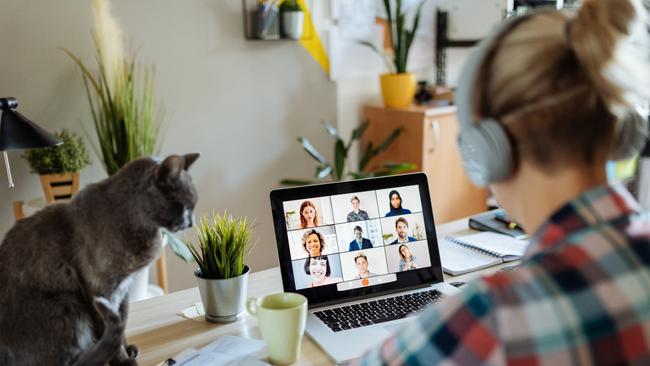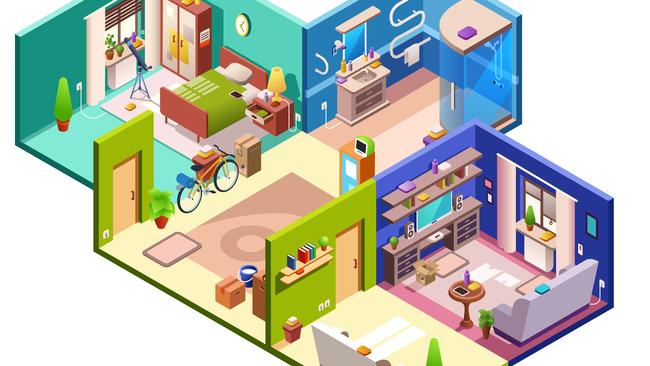Pandemic reshaping Aussie housing wishlists
The pandemic is a schism separating the old world from the new and eight post-Covid social trends could shape the demand and use of housing into the future.

It is a question everyone in property is asking: how will the pandemic shape consumer behaviour in the 2020s?
And the reason why this is such a big question is because there’s so much riding on the answer.
On the one hand, there are those hoping the pandemic is but a (bad) blip from which we will recover with things starting to get back to normal from 2022 onwards.

On the other hand there are those (like me) who regard the pandemic as a schism separating the old world from the new.
Gone is the drudgery of the daily commute; in comes the agility and the personal freedom of working from home (WFH) or indeed from anywhere.
If I am correct, there is much about the post-pandemic world that will change.
And so in order to scope what the future might hold, I offer eight post-Covid social trends that could shape the demand for, or the use of, property in Australia in the 2020s and beyond.
-
Work from home

It could be argued many post-Covid trends are merely accelerations of trends already in train (for example, digitisation).
However, working from home was never a pre-Covid movement; it’s something that has come out of left field, like a comet knocking us off our comfortable trajectory.
Censuses show the proportion of the workforce working from home never exceeded five per cent.
During lockdown this proportion approached 50 per cent (and probably higher in cities such as Canberra).
Most WFH workers will return to the office, but some won’t; they will take the lifestyle option of working from home.
Over the longer term, the proportion of the workforce working from home could settle at about the 10-15 per cent mark.
This would take a net extra million workers out of the daily commute.
What is likely to emerge is a hybrid arrangement where workers work from home Monday and Friday.
This also means the home-office must scale up from a laptop placed on the kitchen table to a fully kitted-out Zoom Room.
This trend might also trigger demand for work near home workspaces.
Plus, I kinda like the idea Darryl Kerrigan’s Pool Room is being reimagined in the post-Covid world as a Zoom Room replete with potted plants and designer table lamps.
WFH property trend: Houses with Zoom rooms
-
CBD versus sub-hub

WFH of course raises the issue of the future of the CBD.
As tempting as working from home may be for many office workers, it isn’t practical for the senior management teams of ASX200 businesses who will continue to work in premium office space.
Indeed, there could emerge a “CBD cachet” prized by workers who simply must work in the city centre.
However, some office workers, as well as knowledge-worker specialists such as consultants, accountants and lawyers, will break down work deliverables into CBD tasks and home tasks.
CBD tasks include activities such as collaborations with co-workers, completion of training; learning programs, meeting with existing clients and schmoozing prospective clients, all of which are activities that need to be prearranged.
What the CBD office loses is spontaneity.
What is gained, however, is greater efficiency; each workplace visit has a purpose.
Plus, tech-geeks assure us spontaneity and happenstance connection is still possible via the advent of clever apps and other “collaboration solutions”.
Work tasks completed in the Zoom room at home are different; these require quiet contemplation, applied creativity or focused concentration in order to deliver an output such as a consulting report, an audited set of accounts, a considered legal opinion or a newspaper column.
And so while working from home may suit many, it won’t suit all, which means we could see the rise of suburban hubs or “sub hubs”.
The suburbs will also be enlivened by hyped activity around logistics and fulfilment centres in the 2020s.
Sub-hub property trend: the rise of work near home workspaces
-
Middle-aged Millennials

These are the children of the Baby Boomers born 1984-2002, now aged 19-37, and who over the next five to six years will push into their late 30s and early 40s.
Indeed, the fastest growing single year of age over the next five years will be 43-year-olds, up 62,000 on today’s number.
The fact is Millennials, the generation that delivered the life form known as the inner-city hipster, are edging ever closer to middle age (which I say starts at 40).
This will trigger a surge in demand for family-friendly residential property in the suburbs because, well, it’s kinda hard to be all chic and minimalist with two (or more) kids working from home in an inner-city apartment.
Expect an uptick in demand for four-bedroom, two-bathroom plus Zoom room homes in the suburbs, or in the near regions.
Millennial property trend: housing upgraders
-
Bucket-list boomers

They are the perennial “faves” of the property industry; these are the Baby Boomers born 1946-1964 and who are now aged 62-75.
This lot have been hippies, punks, DINKs (double income, no kids) and yuppies.
They have been sea-changers and tree-changers.
They will not go quietly into the great abyss of retirement.
They will reinvent this time (65-plus) in the life cycle as the most exciting time of all: kids off their hands, mortgage paid out (hopefully), health still okay (just).
The 2020s is their time to spend the kids’ inheritance and to methodically tick off activities from their ever-expanding bucket list.

In fact, the retirement-straddling Baby Boomers have felt mightily peeved by the pandemic which has, to their way of thinking, diddled them out of two of their remaining good years. Yes, Baby Boomers have thought about their remaining good years.
Once restrictions are lifted expect this lot to book Rhine River Cruises with all the trimmings!
Other over-65 Baby Boomers will do the grandparent shuttle thing, shuffling between the homes of their adult kids and grandkids while others take up causes.
Indeed, we will see the rise of the activist retiree in the 2020s.
Baby Boomers are the first generation of retirees who are educated, opinionated, articulate and with time on their hands.
This is a tricky combination for developers looking to get council approvals for their projects.
Boomer property trend: lock & leave convenience
-
VESPAs & FIZOs

It is not possible to be in the business of demographics and not have cool acronyms.
Here’s two for the 2020s.
Let’s start with Virus Escapees Seeking Provincial Australia, or the VESPAs, who are scootering out of capital cities in search of affordability and serenity in a lifestyle town.
And preferably, a town not too far from the city because, well, VESPAs often take their city job with them, they need to get back to the office every week or so.
I say there is a Goldilocks Zone up to 150km from the CBD that is not too far from and not too close to the city and which is “just right” for the VESPA people.
But what if your employer doesn’t expect you to come to the office more than once every six weeks (like tech company Canva, for example)?
If this is the case, then workers can work from home even further afield and especially during cold Melbourne winters.
We might see the rise of WFH workers working not from home but from an Airbnb apartment on Cairns’ northern beaches.
You’ve heard of Fly-in Fly-out or FIFO workers?
Well, how about Fly-In Zoom-Out or FIZO workers?
Or, better still, Fly-Out Zoom-In or FOZI workers, which is just missing a mid-acronym “N” that would otherwise deliver the FONZIs!
VESPA property trend: work from lifestyle regions
-
In tech we trust

Here’s an example of a trend that was perhaps “in train” pre-Covid, but which has been accelerated by the coronavirus.
In many ways, I see this as the most important social shift caused by the pandemic.
Smartphone users across Australia have been prepped by the pandemic to trust technology.
Whereas many were perhaps reluctant to register online, to use QR codes, to go online to resolve customer service issues prior to the pandemic, citing issues of privacy when reluctance was in fact tied up with “I can’t be bothered” and “I don’t understand”, in the post-Covid world, we let all that go.
Indeed it is “In Tech We Trust” in the 2020s because that’s the only way to get served, to buy things online, to resolve a technical issue: download the app; register now; prove your identity.
Gone (or going) is the ubiquitous call centre operator; in has come Do It Yourself Tech and, once you’ve had a win, once you’ve downloaded and uploaded your proof-of-vaccine, there’s a sense of elation that encourages you to do more.
No one in business or in government can ignore the “techification” of a consumer market that is right now embracing “apps for everything.”
Rightly or wrongly, “in tech we trust” is the way of the future.
“In Tech” property trends: apps for everything
-
Lunch crunch

Now let’s see. A million net extra workers working from home for say two days a week.
That equates to about 92 million net extra lunches per year (say 46 work weeks) prepared in the family home.
Knock off a bit for those who always took their own lunch to the office.
Based on this logic, I say there’s an untapped market for 60 million homemade lunches a year in the post-Covid era as compared with the pre-Covid era.
More supermarket tea and coffee, less food-court sushi.
Greater demand for pre-prepared healthy meals.
What’s snackable, healthy and discretely digestible while doing deals, or more likely dithering, on a Zoom call?
I have no idea, but I am sure we will see it in all good supermarkets very soon.
Could this lead to a new trend: the post-Covid fusion of the cafe and the kitchen? And perhaps to appliances such as espresso machines evolving as elegant appliances to be showcased on waterfall marble island benchtops?
Lunch crunch property trend: cafe-kitchen fusion
-
The New Castle

And so we come to perhaps the greatest social and cultural shift triggered by the pandemic. The collective dwell time in the family home has been boosted by the work from home revolution pandemic.
The greater the dwell time the greater the tendency to invest in the family home — in the new Castle — with new appliances, technology, furniture, furnishings.
If more time is spent by more people in the family home, then it can be rationalised the home should take a greater share of wallet.
Fewer Bali trips; more flat-screen televisions.
I have a theory the home is moving outdoors via the back veranda which, by the way, now goes by the pop-star single name of “alfresco”, and which already accommodates a sink, a small fridge and a six-burner barbie.
How long before there’s a big-screen outdoor TV?
The pre-Covid world was all about being out and about, about seeing and being seen, about promenading with flâneurs and poseurs.
The post-Covid world has recoiled to the cocoon, to the home, to the nest and from which more of us now happily work, shop, study, watch Netflix movies, conduct Telehealth consultations and, oh yes, eat and sleep.
The Castle property trend: (more) home improvement
Bernard Salt is executive director of The Demographics Group; research by data scientist Hari Hara Priya Kanan; graphics by Fiona Evans.






To join the conversation, please log in. Don't have an account? Register
Join the conversation, you are commenting as Logout